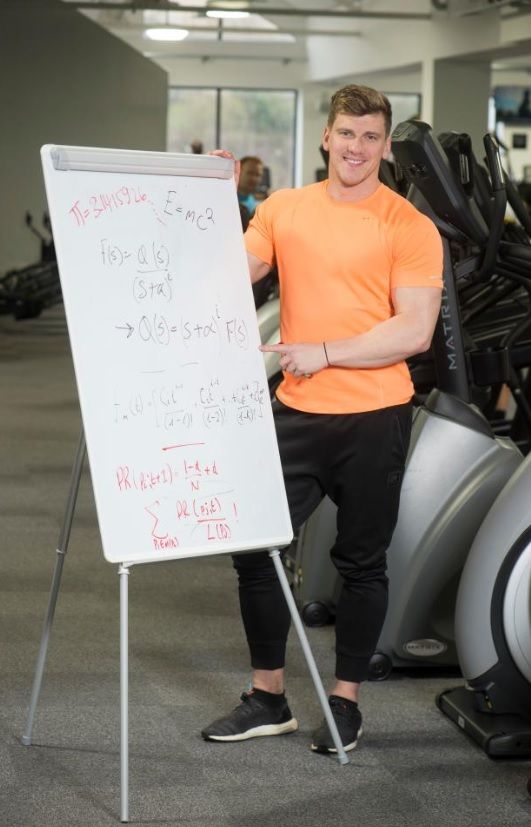Bodybuilder and personal trainer Stu Mac uses an innovative technique to train his clients – maths formulae
Since reaching the final phase of the prestigious Mensa IQ tests, Stu Mac has turned from pure maths to the bodybuilding arena.
Aside from competing, the USN ambassador also works as a personal trainer and coach, incorporating his mathematical background into their programmes.
Here, the Glaswegian shares the science behind the numbers.
Numbers behind the nutrition
Whether you’re looking to get lean or bulk up, there really is a formula for everyone. Stu says:
“This client came to me wanting to drop body fat and improve overall fitness.
“After we talked about her overall lifestyle, I used the TDEE formula to kick things off.”
TDEE stands for Total Daily Energy Expenditure. The equation is:
TDEE = BMR x Activity Factor
Activity factor is a scale of your activity level. For example, leading a sedentary lifestyle measures in at around 1.2 on the scale and the opposite – extremely active – around 1.9.
BMR is your basal metabolic rate. The formula in this case is:
BMR = 655 + (9.6 x weight in kg) + (1.8 x height in cm) – (4.7 x age in years).
While all these numbers may confuse you, it’s not that tricky once you’ve worked out your own stats. Stu says:
“From this formula we plugged in her stats, and out came a TDEE of roughly 2000 calories per day.
“Therefore, the starting diet was made up of 1700 calories, which wasn’t too far off her normal energy expenditure.
“Add in the extra activity from the gym and our sessions, and that number was definitely going to rise.”

Remember, to lose weight you need to be in a calorie deficit where you’re consuming fewer calories than you need to maintain your weight.
Within the calorie quota, Stu also employed a ratio for macronutrients – proteins, carbs and fats.
“Given that this client wanted to cut as fast and efficiently as possible, her starting figures were 40% protein, 30% carbohydrates and 30% fat.”
This worked out at:
- 40% protein / 680 calories = 170g of protein
- 30% carbs / 520 calories = 130g of carbs
- 30% fat / 504 calories = 56g of fat
Progression on the plan also had to be monitored with a keen eye on maths. Stu states that he had his client aim for a 5% loss of body fat each month.
Based on clear data, this style of dieting is so effective because it’s structured and monitored. Stu says:
“Nothing is left to chance compared to standard dieting. In this instance, the client was able to lose a whopping 40lbs and 20% body fat in just 8 months.”
For those of you looking to bulk up in muscle mass, similar formulae are used – but you have to consume more calories than you burn off.
Tracking the training
With weight training, percentage increases are used to help Stu’s clients hit their goals. And just like diet, the principles of progression are still the same. The numbers differ slightly where isolation and compound exercises are concerned.
Isolation exercises work one single muscle at once, and Stu gives a number of key examples.
“With quads, we perform controlled eccentric and concentric reps on the leg extension machine – at 50% of body weight in kg.
“The same method is repeated with hamstrings, but on the lying leg curl machine.”
Revealing the abs owes more to nutrition, but they still need to be trained effectively. Stu employs a specific pre-exhaust method for training these.
https://www.instagram.com/p/Bel-DnYDk3p/?hl=en&taken-by=stumacpt
“It’s very hard to isolate the obliques for example, so for this, I get my clients to do 30 controlled Russian Twists with a 5kg medicine ball.
“This is followed by a side plank timing how long they can hold it.”
Compound exercises activate multiple muscles at once, working from many joints in the process. These are often done with heavier weight.
Examples include:
- Bench Press
- Squat
- Deadlift
- Shoulder Press
- Tricep Dip
“With squats, we perform controlled box squats using 60% of body weight until failure.”
There’s method behind the maths, Stu explains, as the results soon pay dividends.
“Although quite a complicated and methodical approach, it works wonders in terms of muscular development allowing the athlete to progress.”









































